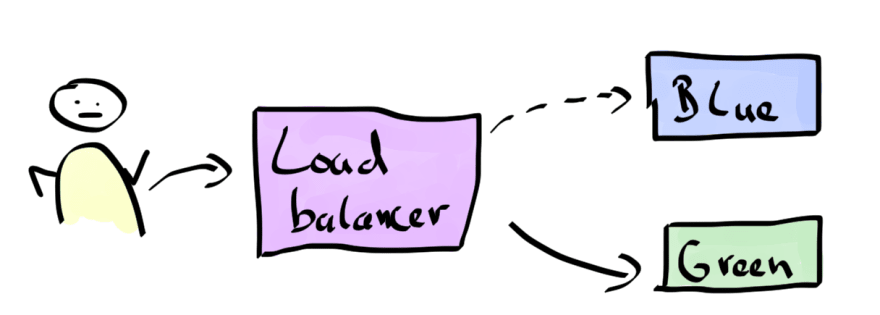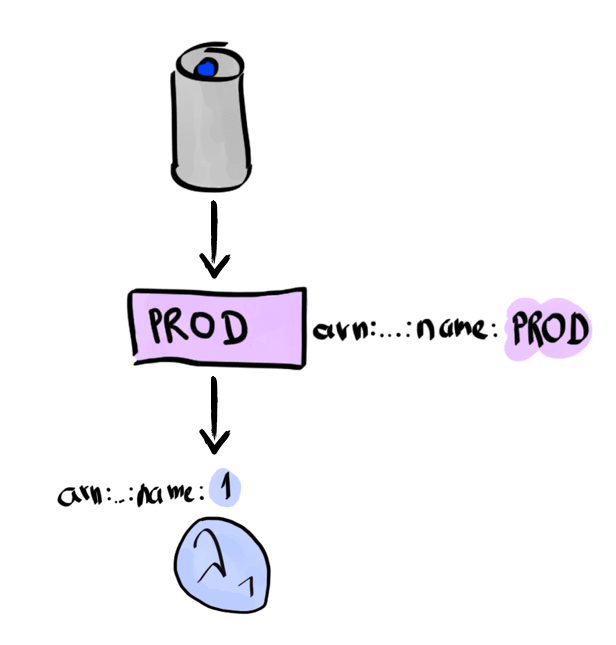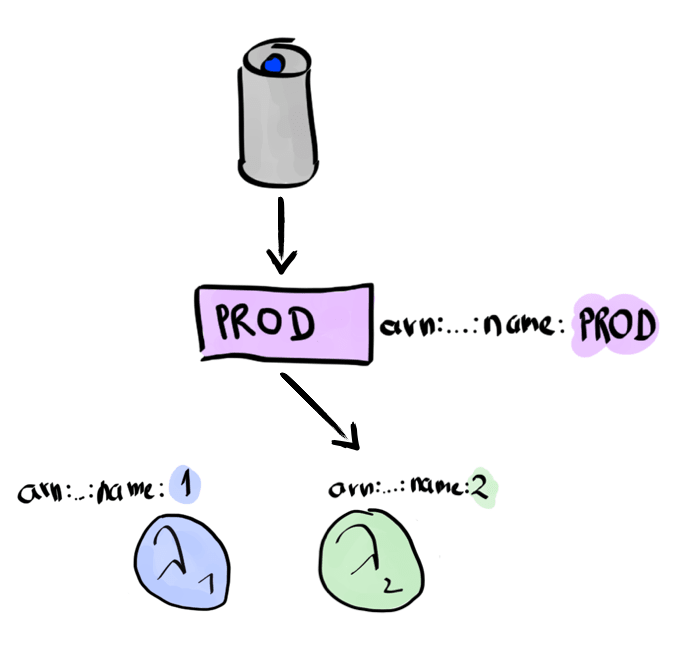Serverless computing is a hot topic. Especially AWS Lambda is gaining traction. It is being used as the foundation of Amazon's Alexa product-line and the basis of entire web sites like A Cloud Guru. We can rapidly build and release new business value to our customers like never before.
That said, we still want to deploy working solutions even at high velocity. Our production releases should be of highest quality and should not endanger any users or depending systems.
Typically we apply techniques like Canary Releases and Blue Green Deployments to reduce the risk of going into production and to be able to easily rollback any broken solutions.
In this short post, I want to introduce you to AWS Lambda traffic shifting. This rather new feature allows us to do Canary Releases and Blue Green Deployments in a Serverless world. I will show you, how to use this to rollout new features in a controlled fashion and how to rollback to a safe point if things go wrong.
If you need a quick refresher on AWS Lambda, please look at a previous post.
Blue Green Deployments and Canary Releases
Before we dive into AWS Lambda traffic shifting, we need to refresh our understanding of Blue Green Deployments and Canary Releases.
When we deploy our solutions to production or update an existing solution, we want to keep downtime at a minimum. In today's world being down for 4 hours of maintenance is simply no viable option anymore.
Blue Green Deployments can help us here. Consider the following illustration.
A customer accesses our system's current version, the Blue Release via a load balancer. Upon release of the new version (the green box) we can wait for the new version to stabilize, e.g. database migrations to take place and so on.
At the time the Green Release is ready to be used, we can switch the load balancer to the the new version without any visible implications to the customer. In addition, if the Green Release somehow fails, we can easily switch back to the Blue Release. A safe haven if things go wrong.
Canary Releases are similar to Blue Green Deployments. They try to reduce the risk of deploying new versions by slowly rolling out the update to a reduced set of users. You could start by directing 10% of incoming traffic to the new Green Release and step wise increase that percentage until you reach 100%. At that point you can decommission the Blue Release.
Versions and Lambda functions
Before we can continue our discussion of Blue Green Deployments and Canaries, we need to look at the exact way, AWS Lambda handles our functions.
Whenever you upload your code to AWS Lambda, AWS stores your code in a S3 bucket. Let's check this using a simple Hello-World Lambda:
exports.handler = (event, context, callback) => {
callback(null, 'Hello World!')
}
We create the Lambda function using the command line. First create the Zip-file containing the code.
$ zip index.zip index.js
Then create the function called TrafficShiftDemo. Note that I refer to a role-arn using $ROLE_ARN, see my previous post if you need help with this...and I have truncated all arns to keep things readable.
$ aws lambda create-function \
--function-name TrafficShiftDemo \
--runtime nodejs6.10 \
--role $ROLE_ARN \
--handler index.handler \
--zip-file fileb://index.zip
{
"FunctionName": "TrafficShiftDemo",
"FunctionArn": "arn:aws:...:TrafficShiftDemo",
"Version": "$LATEST",
...
}
The point I want to stress is the "Version": "$LATEST" field. As the name suggests, $LATEST points to the very latest version.
Contrast this to publishing a Lambda function. First delete the function again.
$ aws lambda delete-function --function-name TrafficShiftDemo
Then re-create and publish the function using the command-line argument --publish.
$ aws lambda create-function \
--function-name TrafficShiftDemo \
--runtime nodejs6.10 \
--role $ROLE_ARN \
--handler index.handler \
--zip-file fileb://index.zip \
--publish
{
"FunctionName": "TrafficShiftDemo",
"FunctionArn": "arn:aws:...:TrafficShiftDemo",
"Version": "1",
...
}
Instead of $LATEST, the function features a version of 1. A published function is essentially an immutable snapshot of the function code and its configuration, such as environment variables.
Consider this illustration.
We publish a Lambda function trice. Version 1, version 2 and version 3 are identifiable by their respective version number. The $LATEST version always points to the most recent version uploaded to AWS Lambda.
Let's modify the function code as follows:
exports.handler = (event, context, callback) => {
callback(null, 'Bonjour le monde!')
}
And now we publish this new code, by updating the Lambda function (don't forget to Zip the code):
$ aws lambda update-function-code \
--function-name TrafficShiftDemo \
--zip-file fileb://index.zip \
--publish
{
"FunctionName": "TrafficShiftDemo",
"FunctionArn": "arn:aws:...:TrafficShiftDemo:2",
"Version": "2",
...
}
Now AWS Lambda informs us, that version 2 has been created.
If we examine the function, AWS Lambda lists all versions. I use JQ to extract the function arn.
$ aws lambda list-versions-by-function \
--function-name TrafficShiftDemo \
|jq '.Versions[] | .FunctionArn'
"arn:aws:...:TrafficShiftDemo:$LATEST"
"arn:aws:...:TrafficShiftDemo:1"
"arn:aws:...:TrafficShiftDemo:2"
You can see the so called fully qualified name of the function. And we can use that name to invoke the different versions.
$ aws lambda invoke \
--function-name arn:aws:...:TrafficShiftDemo:1 out.txt
{
"ExecutedVersion": "1",
"StatusCode": 200
}
$ aws lambda invoke \
--function-name arn:aws:...:TrafficShiftDemo:2 out.txt
{
"ExecutedVersion": "2",
"StatusCode": 200
}
Cloudwatch reports which version was used, too:
START RequestId: 2771b...801f Version: 1
END RequestId: 2771b...801f
REPORT RequestId: 2771b...801f Duration: 33.87 ms Billed Duration: 100 ms Memory Size: 128 MB Max Memory Used: 19 MB
START RequestId: 2dd66...043d Version: 2
END RequestId: 2dd66...043d
REPORT RequestId: 2dd66...043d Duration: 37.58 ms Billed Duration: 100 ms Memory Size: 128 MB Max Memory Used: 19 MB
As I said above, a published function is an immutable snapshot. That also implies, that version numbers are not reused. If, for example, you remove version 2 of the function and publish the function again, then you end up with version 3. Version 2 will never be reused.
$ aws lambda delete-function \
--function-name arn:aws:...:TrafficShiftDemo:2
$ aws lambda update-function-code \
--function-name TrafficShiftDemo \
--zip-file fileb://index.zip \
--publish
{
"FunctionName": "TrafficShiftDemo",
"FunctionArn": "arn:aws:...:TrafficShiftDemo:3",
"Version": "3",
...
}
Stable client with Lambda Aliases
An alias allows us to refer to a specific version of a AWS Lambda function by name. Think of it as a simple logical link, similar to what you would do on a standard *nix-like file system.
Let's create an alias called HELLO for version 1 of our Hello-World Lambda.
$ aws lambda create-alias \
--name HELLO \
--function-name TrafficShiftDemo \
--function-version 1
{
"AliasArn": "arn:aws:...:TrafficShiftDemo:HELLO",
"FunctionVersion": "1",
"Name": "HELLO",
"Description": ""
}
If we invoke the alias, we get our Hello World response, as expected:
$ aws lambda invoke --function-name arn:aws:...:TrafficShiftDemo:HELLO out.txt
{
"ExecutedVersion": "1",
"StatusCode": 200
}
$ cat out.txt
"Hello World!"
AWS Lambda tells us, that we invoked version 1: "ExecutedVersion": "1", just as we wanted.
Now point the alias to the updated french function code:
$ aws lambda update-alias \
--name HELLO \
--function-name TrafficShiftDemo \
--function-version 2
{
"AliasArn": "arn:aws:...:TrafficShiftDemo:HELLO",
"FunctionVersion": "2",
"Name": "HELLO",
"Description": ""
}
If we invoke the alias again, we get the french response:
$ aws lambda invoke \
--function-name arn:aws:...:TrafficShiftDemo:HELLO out.txt
{
"ExecutedVersion": "2",
"StatusCode": 200
}
$ cat out.txt
"Bonjour le monde!"
With this we are able to have a stable client, that only ever calls our alias and we can safely replace the version behind the curtains without ever touching the client.
Consider the example of an Alexa skill that refers to an AWS Lambda alias, without actually knowing which exact version was used. The Alexa skill refers only to the PROD Lambda alias. This in turn aliases version 1 of the actual Lambda function.
After an upgrade to a new version 2 and testing that it works as expected, we update the alias to point to version 2. The Alexa skill need not be updated in any way.
This is all very nice, but how can we actually ensure, that people like our new Lambda function and that it behaves as expected? This brings us to Canary Releases with traffic shifting.
Traffic shifting with AWS Lambda
Traffic shifting is the idea to release an update step-wise in parallel to the current version.
Let's assume we have a Lambda function 1 in production. Now we want to release version 2 but we want to roll out the new version in a safe way.
Traffic shifting to the rescue.
We deploy both versions, 1 and 2. Initially all traffic goes to version 1. But as time progresses we move traffic increasingly to version 2 until at one point 100% of the traffic goes to version 2. At that time version 1 can be decommissioned.
AWS Lambda aliases now support this feature out of the box. We just have to use the new command line argument --routing-config. Before continuing, check the version of your AWS CLI tool, as this is a rather new addition to AWS Lambda. It should read as follows:
$ aws --version
aws-cli/1.14.2
First of all delete the HELLO alias that was created above:
$ aws lambda delete-alias \
--function-name arn:aws:...:TrafficShiftDemo \
--name HELLO
Now create a new alias, that redirects 70% of incoming traffic to version 1 and the remaining 30% to version 2.
$ aws lambda create-alias \
--name HELLO \
--function-name TrafficShiftDemo \
--function-version 2 \
--routing-config AdditionalVersionWeights={'1'=0.7}
The --routing-config AdditionalVersionWeights={'1'=0.7} tells AWS Lambda to redirect 70% of the traffic to version 1, instead of using version 2. You can verify this behavior by invoking the function multiple times an checking the "ExecutedVersion" in the response.
$ aws lambda invoke --function-name arn:aws:...:TrafficShiftDemo:HELLO out.txt
{
"ExecutedVersion": "2",
"StatusCode": 200
}
$ aws lambda invoke --function-name arn:aws:...:TrafficShiftDemo:HELLO out.txt
{
"ExecutedVersion": "1",
"StatusCode": 200
}
$ aws lambda invoke --function-name arn:aws:...:TrafficShiftDemo:HELLO out.txt
{
"ExecutedVersion": "1",
"StatusCode": 200
}
We can finally release new Lambda functions and check their behavior and impact in a truly agile way.
Summary
Traffic shifting is an important part of Blue Green Deployments and Canary releases. With this new feature, we can release new business functions and see how people are using it and how the market reacts to it. Think of simple things like testing if people like seeing more details about a movie on a streaming service instead of just the title and the running time.
And think about this again: no extra loadbalancer, no extra infrastructure. This is what I call serverless.
If you want to dig deeper into this topic, I urge you to look at AWS Codedeploy which automates rolling-updates and rollbacks even further. With Codedeploy you can configure your Lambda to scale up to the new version with a rate of 10% every 5min, for example.
In a follow-up, I will cover an integrated example, that brings Lambda, traffic shifting, Codedeploy and the Serverless Application Model together into a truly serverless continuous delivery pipeline.







Latest comments (4)
Thanks for this post. I was so confused as how to code deploy worked with lambda from just reading the aws docs.
Your blog held my interest right to the very end, which is not always an easy thing to do!! A debt of gratitude is in order for the decent blog. It was extremely helpful for me. Continue sharing such thoughts later on too. This was really what I was searching for, and I am happy to come here!
fastcustomessaywriting.com/
Great write up on canary release in Lambda David! It is great that AWS finally provided this feature for Lambda and you do a great job demonstrating it.
Thank you, Kyle.
I really love to see Lambda mature this way. I firmly believe, that this is the way forward :D